Assessing the Roles of Terrestrial Stilling and Solar Dimming in Land Surface Drying/Wetting across China
Abstract
1. Introduction
2. Methods
2.1. Climate Data
2.2. Dryness Indicator
2.3. Attribution Analysis
3. Results
3.1. Observed Long-Term Trends in Climate
3.2. Drying/Wetting Patterns
3.3. Independent Effects of individual Climatic Variables
4. Discussion
4.1. Linkage with Large-Scale Climate Change and Socio-Economic Developments
4.2. Implications for Water and Land Management
4.3. Caveats
5. Conclusions
Author Contributions
Funding
Conflicts of Interest
References
- Dai, A. Increasing drought under global warming in observations and models. Nat. Clim. Chang. 2012, 3, 52–58. [Google Scholar] [CrossRef]
- Feng, S.; Fu, Q. Expansion of global drylands under a warming climate. Atmos. Chem. Phys 2013, 13, 10.081–010.094. [Google Scholar] [CrossRef]
- Ma, Z.; Fu, C. Some evidence of drying trend over northern China from 1951 to 2004. Chin. Sci. Bull. 2006, 51, 2913–2925. [Google Scholar] [CrossRef]
- Milly, P.C.D.; Dunne, K.A.; Vecchia, A.V. Global pattern of trends in streamflow and water availability in a changing climate. Nature 2005, 438, 347–350. [Google Scholar] [CrossRef] [PubMed]
- Piao, S.; Ciais, P.; Huang, Y.; Shen, Z.; Peng, S.; Li, J.; Zhou, L.; Liu, H.; Ma, Y.; Ding, Y.; et al. The impacts of climate change on water resources and agriculture in China. Nature 2010, 467, 43–51. [Google Scholar] [CrossRef] [PubMed]
- Westerling, A.L.; Hidalgo, H.G.; Cayan, D.R.; Swetnam, T.W. Warming and Earlier Spring Increase Western U.S. Forest Wildfire Activity. Science 2006, 313, 940–943. [Google Scholar] [CrossRef]
- Reynolds, J.F.; Smith, D.M.S.; Lambin, E.F.; Turner, B.; Mortimore, M.; Batterbury, S.P.; Downing, T.E.; Dowlatabadi, H.; Fernández, R.J.; Herrick, J.E. Global desertification: Building a science for dryland development. Science 2007, 316, 847–851. [Google Scholar] [CrossRef]
- Wu, S.; Yin, Y.; Zheng, D.; Yang, Q. Aridity/humidity status of land surface in china during the last three decades. Sci. China Series D Earth Sci. 2005, 48, 1510–1518. [Google Scholar] [CrossRef]
- Duan, K.; Mei, Y. Comparison of meteorological, hydrological and agricultural drought responses to climate change and uncertainty assessment. Water Resour. Manag. 2014, 28, 5039–5054. [Google Scholar] [CrossRef]
- Chen, H.; Sun, J. Changes in drought characteristics over china using the standardized precipitation evapotranspiration index. J. Clim. 2015, 28, 5430–5447. [Google Scholar] [CrossRef]
- Sherwood, S.; Fu, Q. A Drier Future? Science 2014, 343, 737–739. [Google Scholar] [CrossRef] [PubMed]
- Allen, R.G.; Pereira, L.S.; Raes, D.; Smith, M. Crop Evapotranspiration-Guidelines for Computing Crop Water Requirements-Fao Irrigation and Drainage Paper 56; FAO: Rome, Italy, 1998; p. D05109. [Google Scholar]
- Kingston, D.G.; Todd, M.C.; Taylor, R.G.; Thompson, J.R.; Arnell, N.W. Uncertainty in the estimation of potential evapotranspiration under climate change. Geophys. Res. Lett. 2009, 36, L20403. [Google Scholar] [CrossRef]
- McKenney, M.S.; Rosenberg, N.J. Sensitivity of some potential evapotranspiration estimation methods to climate change. Agric. For. Meteorol. 1993, 64, 81–110. [Google Scholar] [CrossRef]
- Duan, K.; Sun, G.; McNulty, S.; Caldwell, P.V.; Cohen, E.C.; Sun, S.; Aldridge, H.D.; Zhou, D.; Zhang, L.; Zhang, Y. Future shift of the relative roles of precipitation and temperature in controlling annual runoff in the conterminous United States. Hydrol. Earth Syst. Sci. 2017, 21, 5517–5529. [Google Scholar] [CrossRef]
- Wang, L.; Chen, W. A CMIP5 multimodel projection of future temperature, precipitation, and climatological drought in China. Int. J. Clim. 2013, 34, 2059–2078. [Google Scholar] [CrossRef]
- Lu, J.; Sun, G.; McNulty, S.; Amatya, D.M. A comparison of six potential evapotranspiration methods for regional use in the southeastern united states. JAWRA J. Am. Water Resour. Assoc. 2005, 41, 621–633. [Google Scholar] [CrossRef]
- Milly, P.C.; Dunne, K.A. On the hydrologic adjustment of climate-model projections: The potential pitfall of potential evapotranspiration. Earth Interact. 2011, 15, 1–14. [Google Scholar] [CrossRef]
- Sheffield, J.; Wood, E.F.; Roderick, M.L. Little change in global drought over the past 60 years. Nature 2012, 491, 435–438. [Google Scholar] [CrossRef]
- McVicar, T.R.; Roderick, M.L.; Donohue, R.J.; Li, L.T.; Van Niel, T.G.; Thomas, A.; Grieser, J.; Jhajharia, D.; Himri, Y.; Mahowald, N.M. Global review and synthesis of trends in observed terrestrial near-surface wind speeds: Implications for evaporation. J. Hydrol. 2012, 416, 182–205. [Google Scholar] [CrossRef]
- Wild, M. Global dimming and brightening: A review. J. Geophys. Res. Space Phys. 2009, 114. [Google Scholar] [CrossRef]
- Bohn, T.J.; Livneh, B.; Oyler, J.W.; Running, S.W.; Nijssen, B.; Lettenmaier, D.P. Global evaluation of mtclim and related algorithms for forcing of ecological and hydrological models. Agric. For. Meteorol. 2013, 176, 38–49. [Google Scholar] [CrossRef]
- Greve, P.; Orlowsky, B.; Mueller, B.; Sheffield, J.; Reichstein, M.; Seneviratne, S.I. Global assessment of trends in wetting and drying over land. Nat. Geosci. 2014, 7, 716–721. [Google Scholar] [CrossRef]
- Yang, T.; Ding, J.; Liu, D.; Wang, X.; Wang, T. Combined use of multiple drought indices for global assessment of dry gets drier and wet gets wetter paradigm. J. Clim. 2019, 32, 737–748. [Google Scholar] [CrossRef]
- Liu, C.; Zhang, D.; Liu, X.; Zhao, C. Spatial and temporal change in the potential evapotranspiration sensitivity to meteorological factors in china (1960–2007). J. Geogr. Sci. 2012, 22, 3–14. [Google Scholar] [CrossRef]
- Xu, C.-y.; Gong, L.; Jiang, T.; Chen, D.; Singh, V.P. Analysis of spatial distribution and temporal trend of reference evapotranspiration and pan evaporation in changjiang (yangtze river) catchment. J. Hydrol. 2006, 327, 81–93. [Google Scholar] [CrossRef]
- Zhang, Q.; Xu, C.-Y.; Chen, X. Reference evapotranspiration changes in china: Natural processes or human influences? Theor. Appl. Clim. 2011, 103, 479–488. [Google Scholar] [CrossRef]
- Liu, X.; Luo, Y.; Zhang, D.; Zhang, M.; Liu, C. Recent changes in pan-evaporation dynamics in china. Geophys. Res. Lett. 2011, 38. [Google Scholar] [CrossRef]
- Brutsaert, W.; Parlange, M.B. Hydrologic cycle explains the evaporation paradox. Nature 1998, 396. [Google Scholar] [CrossRef]
- Hulme, M. Recent climatic change in the world’s drylands. Geophys. Res. Lett. 1996, 23, 61–64. [Google Scholar] [CrossRef]
- Middleton, N.J.; Thomas, D.S. Unep: World Atlas of Desertification; Arnold: London, UK, 1997. [Google Scholar]
- Roderick, M.L.; Rotstayn, L.D.; Farquhar, G.D.; Hobbins, M.T. On the attribution of changing pan evaporation. Geophys. Res. Lett. 2007, 34. [Google Scholar] [CrossRef]
- Chen, C.; Park, T.; Wang, X.; Piao, S.; Xu, B.; Chaturvedi, R.K.; Fuchs, R.; Brovkin, V.; Ciais, P.; Fensholt, R. China and india lead in greening of the world through land-use management. Nat. Sustain. 2019, 2, 122. [Google Scholar] [CrossRef] [PubMed]
- Piao, S.; Yin, G.; Tan, J.; Cheng, L.; Huang, M.; Li, Y.; Liu, R.; Mao, J.; Myneni, R.B.; Peng, S. Detection and attribution of vegetation greening trend in china over the last 30 years. Glob. Chang. Biol. 2015, 21, 1601–1609. [Google Scholar] [CrossRef] [PubMed]
- Fu, B. Blue skies for china. Science 2008, 321, 611. [Google Scholar] [CrossRef] [PubMed][Green Version]
- Kendall, M.G. Rank Correlation Methods; Hafner Publishing Company: New York, NY, USA, 1962. [Google Scholar]
- Yue, S.; Pilon, P.; Cavadias, G. Power of the mann–kendall and spearman’s rho tests for detecting monotonic trends in hydrological series. J. Hydrol. 2002, 259, 254–271. [Google Scholar] [CrossRef]
- Greve, P.; Seneviratne, S.I. Assessment of future changes in water availability and aridity. Geophys. Res. Lett. 2015, 42, 5493–5499. [Google Scholar] [CrossRef]
- IPCC. Climate Change 2014: Synthesis Report. Contribution of Working Groups i, ii and iii to the Fifth Assessment Report of the Intergovernmental Panel on Climate Change; 9291691437; IPCC: Geneva, Switzerland, 2014. [Google Scholar]
- Yu, R.; Wang, B.; Zhou, T. Tropospheric cooling and summer monsoon weakening trend over east asia. Geophys. Res. Lett. 2004, 31. [Google Scholar] [CrossRef]
- Zhang, C.; Tang, Q.; Chen, D.; Li, L.; Liu, X.; Cui, H. Tracing changes in atmospheric moisture supply to the drying southwest china. Atmos. Chem. Phys. Discuss. 2017, 17, 10383–10393. [Google Scholar] [CrossRef]
- Fu, B.; Wang, S.; Liu, Y.; Liu, J.; Liang, W.; Miao, C. Hydrogeomorphic ecosystem responses to natural and anthropogenic changes in the loess plateau of china. Annu. Rev. Earth Planet. Sci. 2017, 45, 223–243. [Google Scholar] [CrossRef]
- Zeng, Z.; Piao, S.; Li, L.Z.X.; Ciais, P.; Li, Y.; Cai, X.; Yang, L.; Liu, M.; Wood, E.F. Global terrestrial stilling: Does earth’s greening play a role? Environ. Res. Lett. 2018, 13, 124013. [Google Scholar] [CrossRef]
- Parungo, F.; Li, Z.; Li, X.; Yang, D.; Harris, J. Gobi dust storms and the great green wall. Geophys. Res. Lett. 1994, 21, 999–1002. [Google Scholar] [CrossRef]
- Chen, J.; Li, Q.; Niu, J.; Sun, L. Regional climate change and local urbanization effects on weather variables in southeast china. Stoch. Environ. Res. Risk Assess. 2011, 25, 555–565. [Google Scholar] [CrossRef]
- Peng, S.; Piao, S.; Ciais, P.; Friedlingstein, P.; Ottle, C.; Breon, F.M.; Nan, H.; Zhou, L.; Myneni, R.B. Surface urban heat island across 419 global big cities. Environ. Sci. Technol. 2012, 46, 696–703. [Google Scholar] [CrossRef] [PubMed]
- Hao, L.; Huang, X.; Qin, M.; Liu, Y.; Li, W.; Sun, G. Ecohydrological processes explain urban dry island effects in a wet region, southern china. Water Resour. Res. 2018, 54, 6757–6771. [Google Scholar] [CrossRef]
- Gedney, N.; Huntingford, C.; Weedon, G.; Bellouin, N.; Boucher, O.; Cox, P. Detection of solar dimming and brightening effects on northern hemisphere river flow. Nat. Geosci. 2014, 7, 796–800. [Google Scholar] [CrossRef]
- Ramanathan, V.; Crutzen, P.; Kiehl, J.; Rosenfeld, D. Aerosols, climate, and the hydrological cycle. Science 2001, 294, 2119–2124. [Google Scholar] [CrossRef]
- Duan, K.; Sun, G.; Zhang, Y.; Yahya, K.; Wang, K.; Madden, J.M.; Caldwell, P.V.; Cohen, E.C.; McNulty, S.G. Impact of air pollution induced climate change on water availability and ecosystem productivity in the conterminous united states. Clim. Chang. 2017, 140, 259–272. [Google Scholar] [CrossRef]
- Liu, Y.; Cai, W.; Sun, C.; Song, H.; Cobb, K.M.; Li, J.; Leavitt, S.W.; Wu, L.; Cai, Q.; Liu, R.; et al. Anthropogenic aerosols cause recent pronounced weakening of asian summer monsoon relative to last four centuries. Geophys. Res. Lett. 2019, 46, 5469–5479. [Google Scholar] [CrossRef]
- Alpert, P.; Kishcha, P.; Kaufman, Y.J.; Schwarzbard, R. Global dimming or local dimming?: Effect of urbanization on sunlight availability. Geophys. Res. Lett. 2005, 32. [Google Scholar] [CrossRef]
- de la Paix, M.J.; Lanhai, L.; Jiwen, G.; de Dieu, H.J.; Theoneste, N. Analysis of snowmelt model for flood forecast for water in arid zone: Case of tarim river in northwest china. Environ. Earth Sci. 2012, 66, 1423–1429. [Google Scholar] [CrossRef]
- Feng, X.; Cheng, W.; Fu, B.; Lu, Y. The role of climatic and anthropogenic stresses on long-term runoff reduction from the loess plateau, china. Sci. Total Environ. 2016, 571, 688–698. [Google Scholar] [CrossRef]
- Liu, C.; Zheng, H. South-to-north water transfer schemes for china. Int. J. Water Resour. Dev. 2002, 18, 453–471. [Google Scholar] [CrossRef]
- Zhao, X.; Liu, J.; Liu, Q.; Tillotson, M.R.; Guan, D.; Hubacek, K. Physical and virtual water transfers for regional water stress alleviation in china. Proc. Natl. Acad. Sci. USA 2015, 112, 1031–1035. [Google Scholar] [CrossRef] [PubMed]
- Duan, K.; Caldwell, P.V.; Sun, G.; McNulty, S.G.; Zhang, Y.; Shuster, E.; Liu, B.; Bolstad, P.V. Understanding the role of regional water connectivity in mitigating climate change impacts on surface water supply stress in the united states. J. Hydrol. 2019, 570, 80–95. [Google Scholar] [CrossRef]
- Challinor, A.; Watson, J.; Lobell, D.; Howden, S.; Smith, D.; Chhetri, N. A meta-analysis of crop yield under climate change and adaptation. Nat. Clim. Chang. 2014, 4, 287–291. [Google Scholar] [CrossRef]
- Teixeira, E.I.; Fischer, G.; van Velthuizen, H.; Walter, C.; Ewert, F. Global hot-spots of heat stress on agricultural crops due to climate change. Agric. For. Meteorol. 2013, 170, 206–215. [Google Scholar] [CrossRef]
- Dale, V.H.; Joyce, L.A.; McNulty, S.; Neilson, R.P.; Ayres, M.P.; Flannigan, M.D.; Hanson, P.J.; Irland, L.C.; Lugo, A.E.; Peterson, C.J. Climate change and forest disturbances climate change can affect forests by altering the frequency, intensity, duration, and timing of fire, drought, introduced species, insect and pathogen outbreaks, hurricanes, windstorms, ice storms, or landslides. BioScience 2001, 51, 723–734. [Google Scholar] [CrossRef]
- Hallema, D.W.; Sun, G.; Caldwell, P.V.; Norman, S.P.; Cohen, E.C.; Liu, Y.; Bladon, K.D.; McNulty, S.G. Burned forests impact water supplies. Nat. Commun. 2018, 9, 1307. [Google Scholar] [CrossRef]
- Sun, G.; Caldwell, P.V.; McNulty, S.G. Modelling the potential role of forest thinning in maintaining water supplies under a changing climate across the conterminous united states. Hydrol. Process. 2015, 29, 5016–5030. [Google Scholar] [CrossRef]
- Vose, J.M.; Miniat, C.F.; Luce, C.H.; Asbjornsen, H.; Caldwell, P.V.; Campbell, J.L.; Grant, G.E.; Isaak, D.J.; Loheide, S.P.; Sun, G. Ecohydrological implications of drought for forests in the united states. For. Ecol. Manag. 2016, 380, 335–345. [Google Scholar] [CrossRef]
- Feng, X.; Fu, B.; Piao, S.; Wang, S.; Ciais, P.; Zeng, Z.; Lü, Y.; Zeng, Y.; Li, Y.; Jiang, X. Revegetation in china’s loess plateau is approaching sustainable water resource limits. Nat. Clim. Chang. 2016, 6, 1019–1022. [Google Scholar] [CrossRef]
- Tang, T.; Shindell, D.; Samset, B.H.; Boucher, O.; Forster, P.M.; Hodnebrog, Ø.; Myhre, G.; Sillmann, J.; Voulgarakis, A.; Andrews, T. Dynamical response of mediterranean precipitation to greenhouse gases and aerosols. Atmos. Chem. Phys. 2018, 18, 8439–8452. [Google Scholar] [CrossRef]
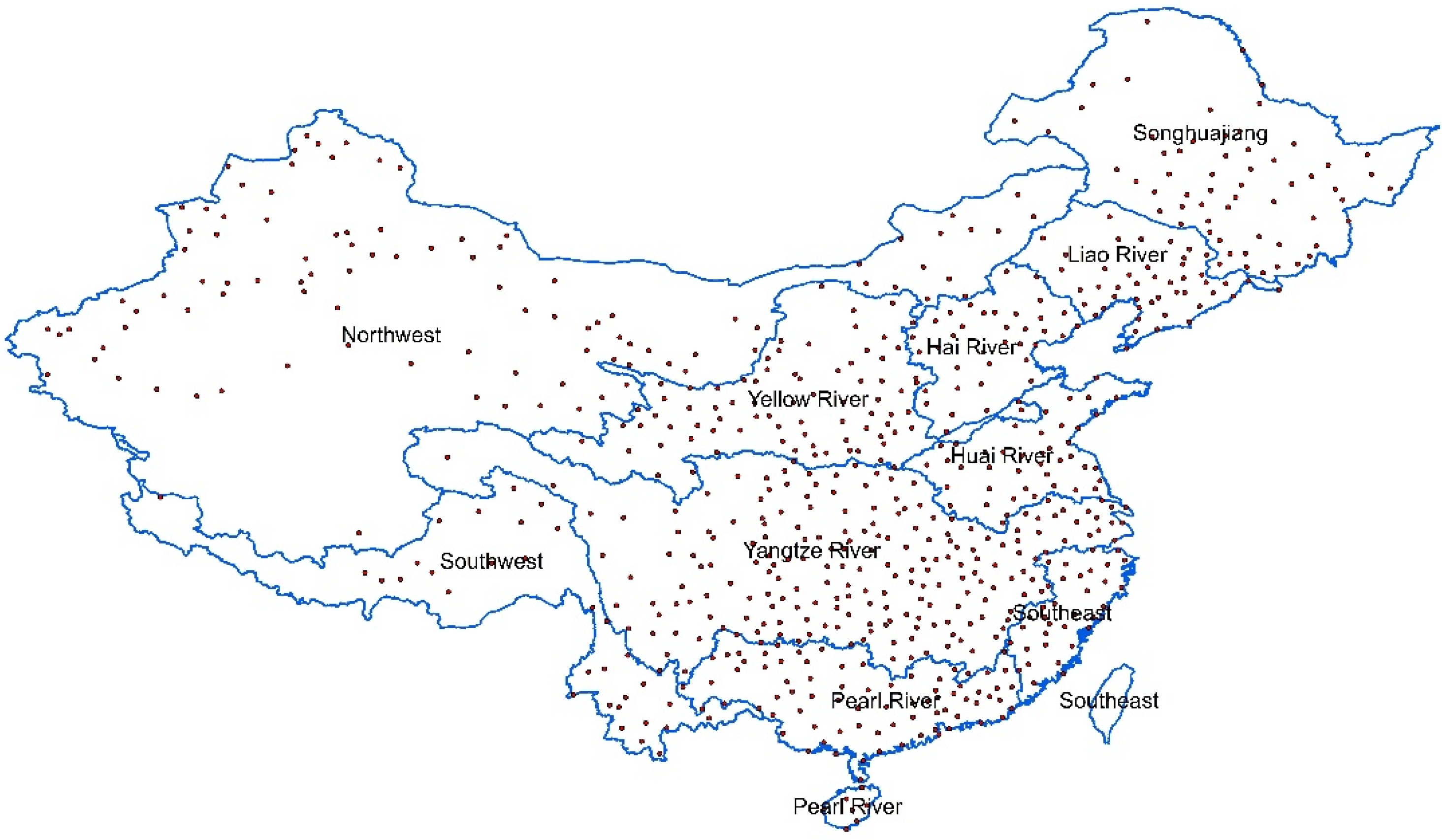

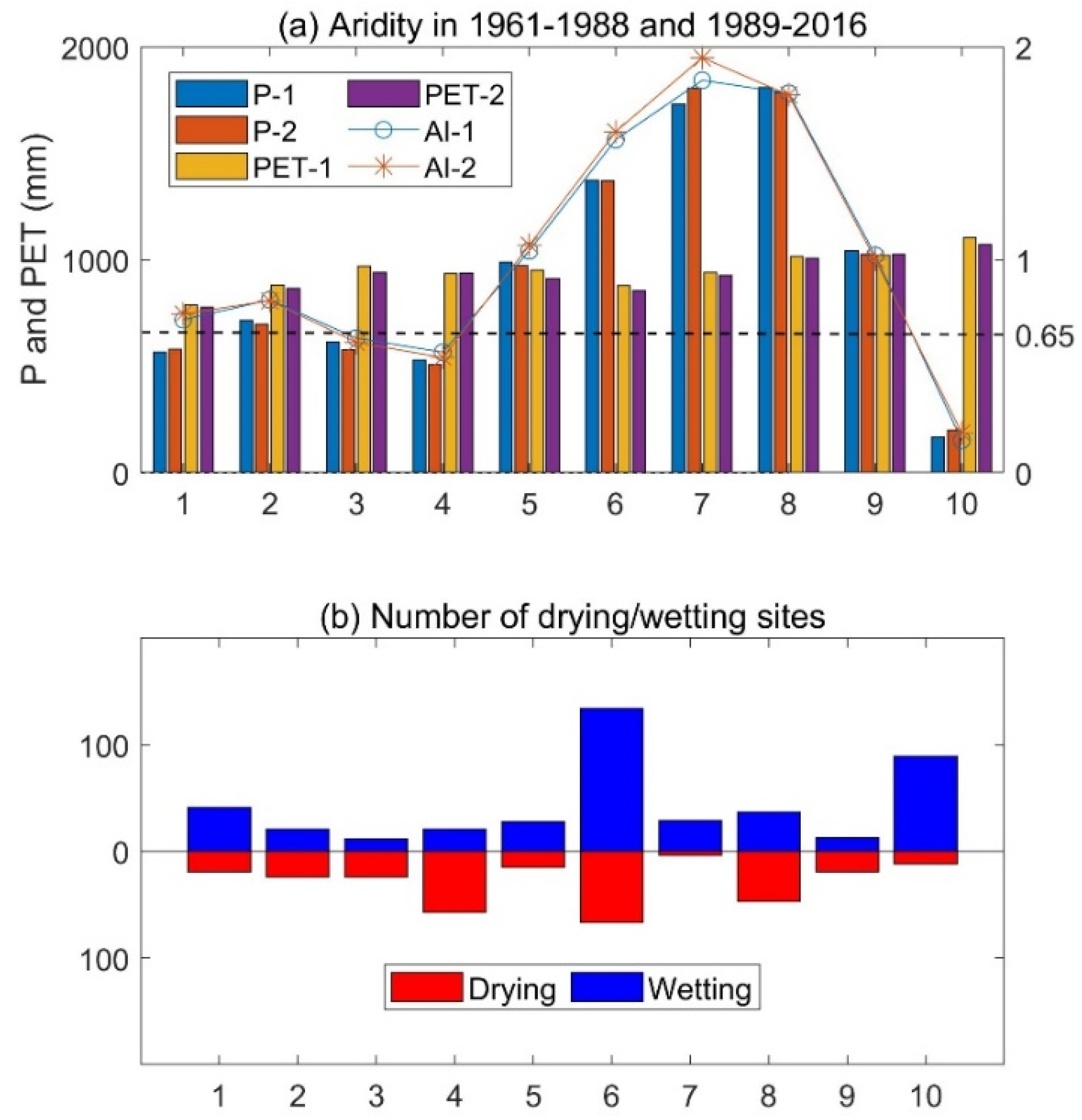
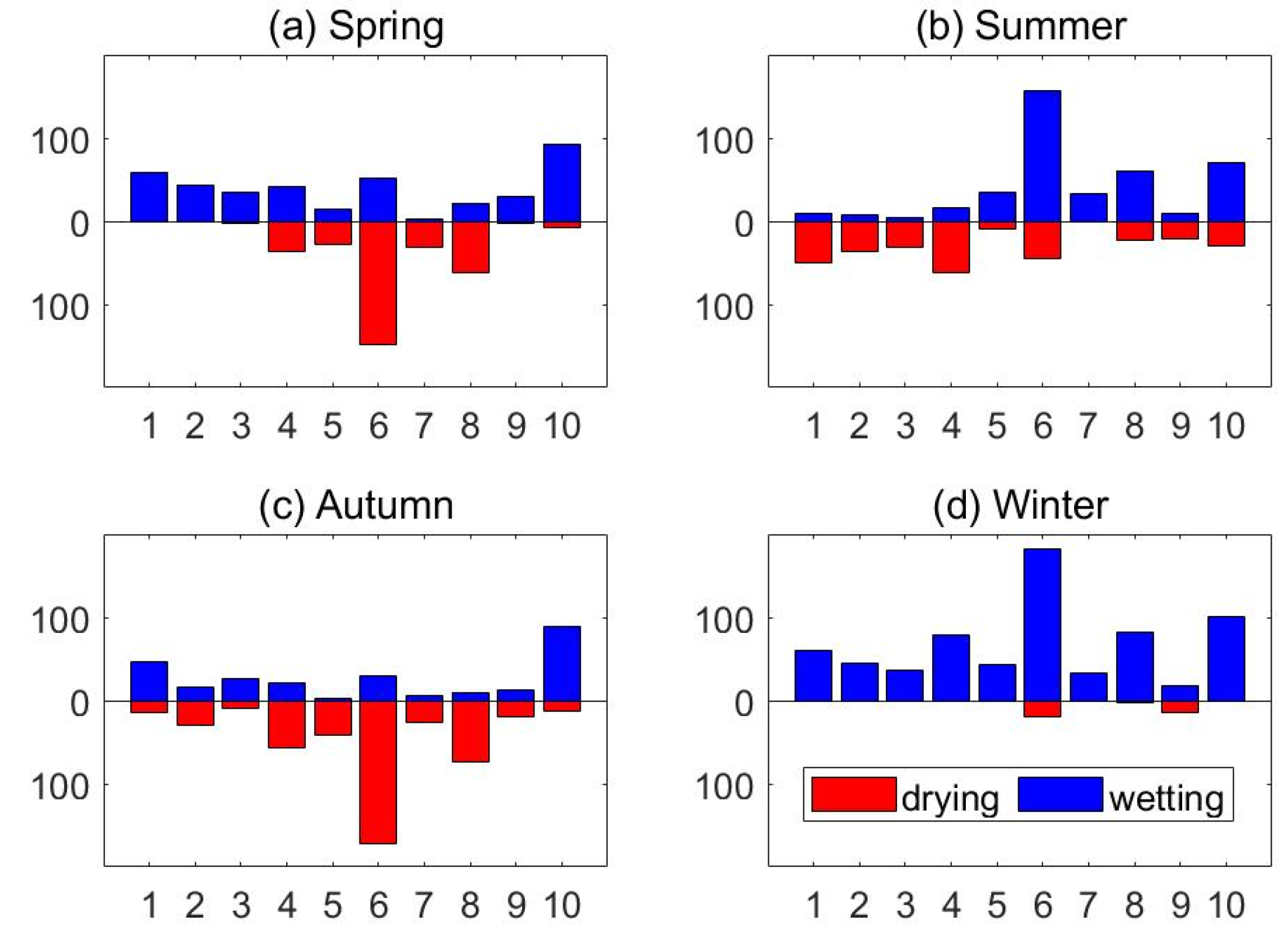
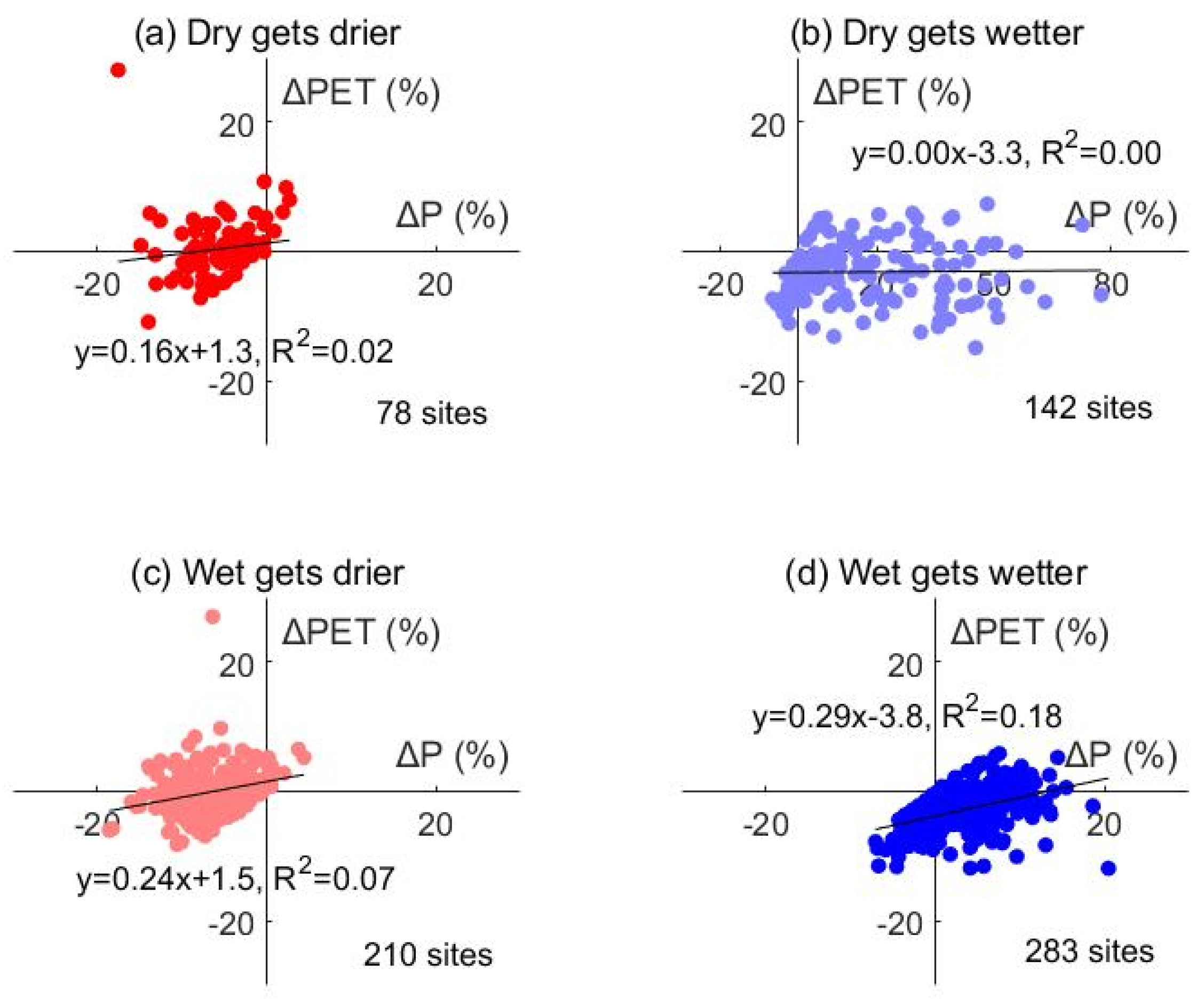
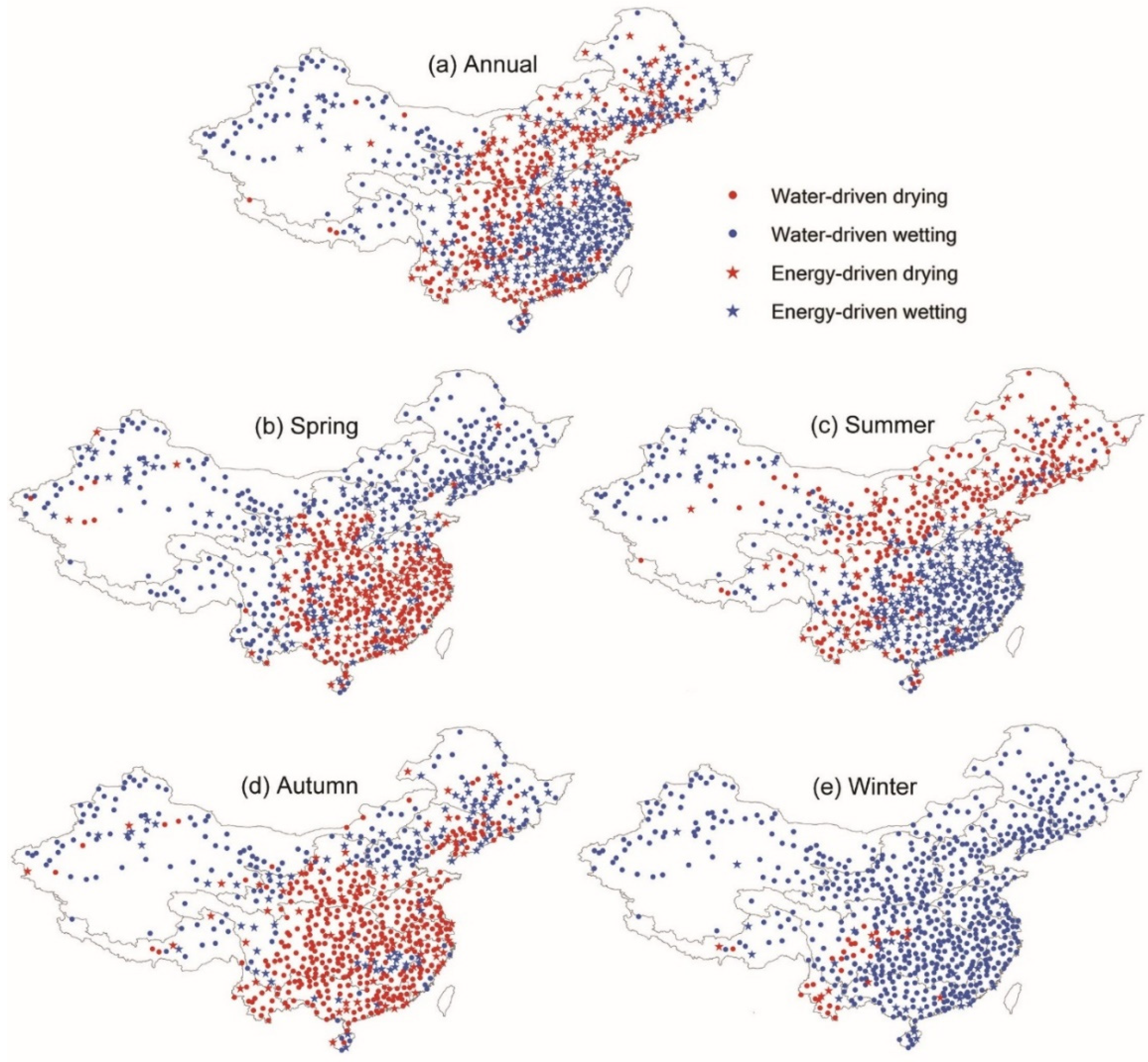
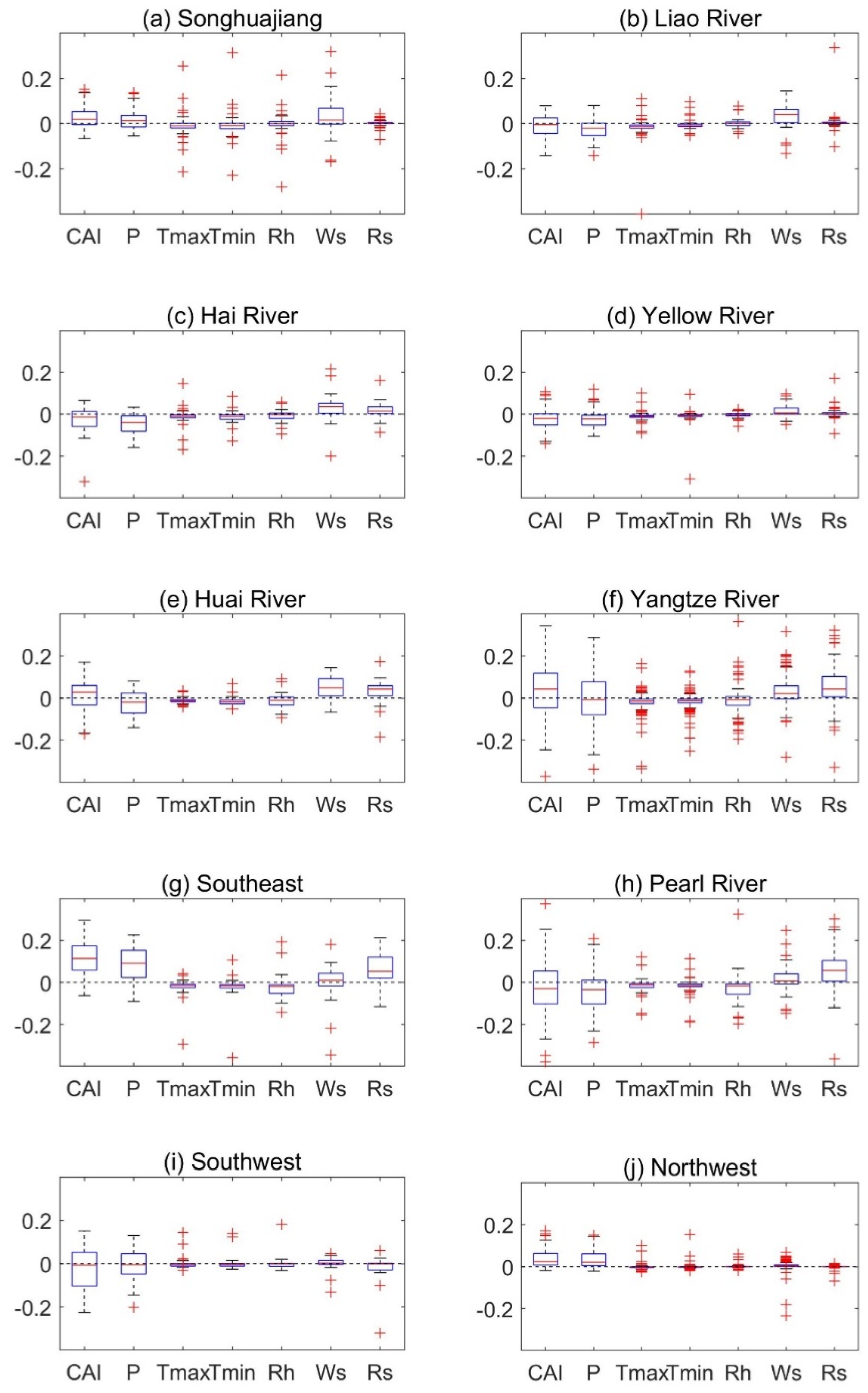
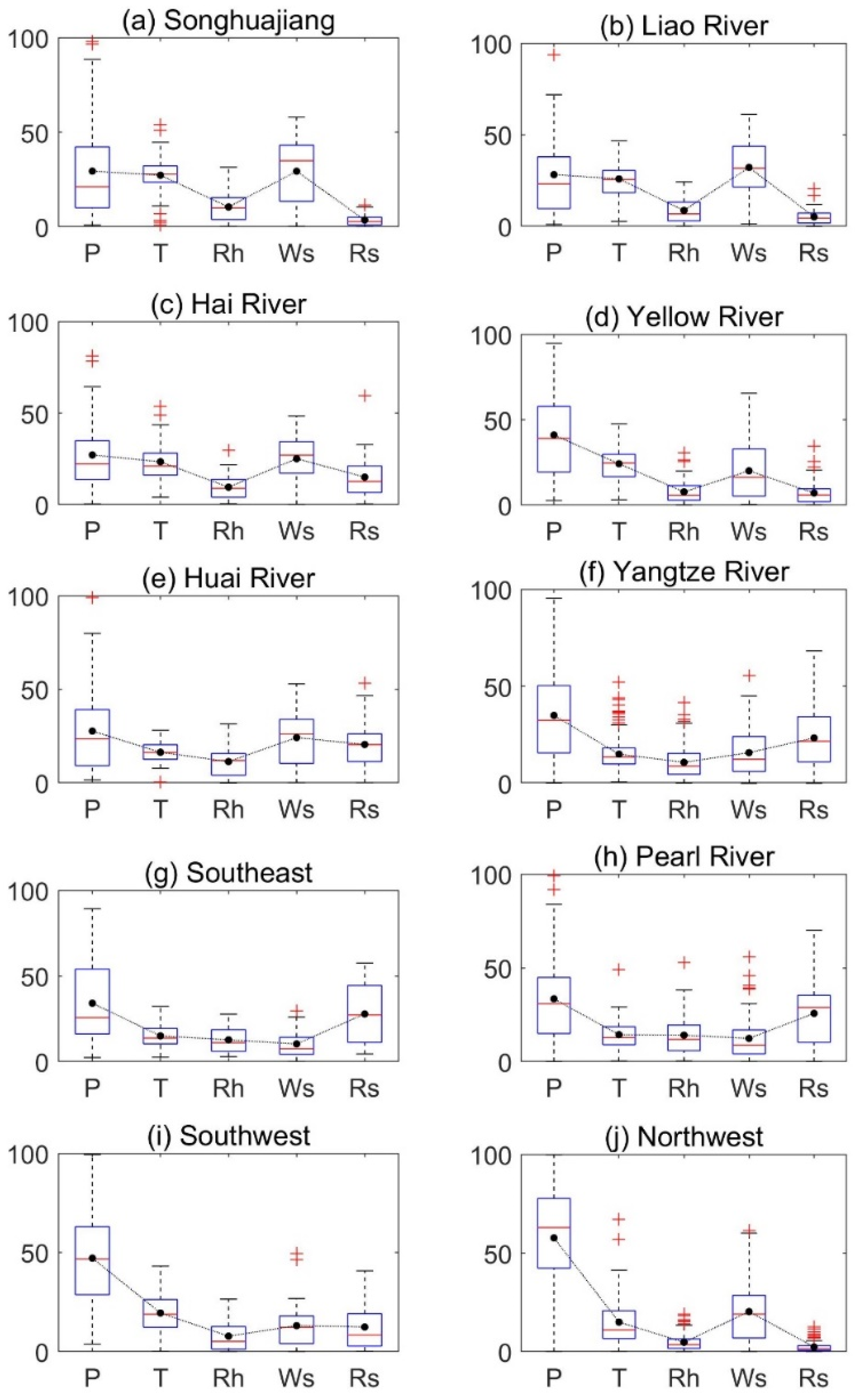
| Category | Aridity Index |
|---|---|
| Hyper-arid | <0.05 |
| Arid | 0.05 to 0.2 |
| Semi-arid | 0.2 to 0.5 |
| Dry sub-humid | 0.5 to 0.65 |
| Sub-humid | 0.65 to 0.75 |
| Humid | >0.75 |
| ID | Basin | Sites | Area (104 km2) | P (mm) | Tmax (℃) | Tmin (℃) | Rh (%) | Ws (m/s) | Rs (MJ m−2 d−1) | PET (mm) | AI |
|---|---|---|---|---|---|---|---|---|---|---|---|
| 1 | Songhuajiang | 60 | 90 | 573 | 9.4 | −2.7 | 65.0 | 3.0 | 13.3 | 783 | 0.73 |
| 2 | Liao River | 45 | 35 | 709 | 13.7 | 2.3 | 62.0 | 2.8 | 13.4 | 873 | 0.81 |
| 3 | Hai River | 36 | 32 | 596 | 16.4 | 4.8 | 59.6 | 2.5 | 14.0 | 956 | 0.62 |
| 4 | Yellow River | 78 | 79 | 517 | 15.0 | 2.5 | 59.3 | 2.2 | 14.6 | 936 | 0.55 |
| 5 | Huai River | 43 | 33 | 981 | 19.4 | 10.0 | 71.5 | 2.7 | 12.9 | 930 | 1.05 |
| 6 | Yangtze River | 201 | 181 | 1369 | 20.5 | 11.9 | 75.9 | 1.9 | 11.6 | 866 | 1.58 |
| 7 | Southeast | 33 | 24 | 1766 | 23.3 | 14.6 | 78.5 | 1.8 | 12.4 | 933 | 1.89 |
| 8 | Pearl River | 84 | 58 | 1802 | 25.2 | 17.2 | 78.5 | 1.9 | 12.7 | 1011 | 1.78 |
| 9 | Southwest | 32 | 85 | 1035 | 19.3 | 6.5 | 64.2 | 1.6 | 16.1 | 1023 | 1.01 |
| 10 | Northwest | 101 | 337 | 183 | 13.9 | 0.1 | 49.2 | 2.7 | 16.0 | 1086 | 0.17 |
| Largest Driver | Drying/Wetting Pattern | No. of Sites | Changing Direction | No. of Sites | Changing Direction + Drying/Wetting | No. of Sites |
|---|---|---|---|---|---|---|
| P | Dry gets drier | 5.3% | P ↘ | 25% | P ↘ + drying | 24% |
| Wet gets drier | 19% | |||||
| Dry gets wetter | 13% | P ↗ | 27% | P ↗ + wetting | 27% | |
| Wet gets wetter | 14% | |||||
| T | Dry gets drier | 2.2% | T ↗ | 6.0% | T ↗ + drying | 5.8% |
| Wet gets drier | 3.5% | |||||
| Dry gets wetter | 0.7% | T ↘ | 2.4% | T ↘ + wetting | 2.4% | |
| Wet gets wetter | 2.0% | |||||
| Rh | Dry gets drier | 0.0% | Rh ↘ | 0.8% | Rh ↘ + drying | 0.6% |
| Wet gets drier | 0.6% | |||||
| Dry gets wetter | 0.1% | Rh ↗ | 0.8% | Rh ↗ + wetting | 0.8% | |
| Wet gets wetter | 1.0% | |||||
| Ws | Dry gets drier | 3.2% | Ws ↗ | 2.7% | Ws ↗ + drying | 2.7% |
| Wet gets drier | 3.4% | |||||
| Dry gets wetter | 5.3% | Ws ↘ | 19% | Ws ↘ + wetting | 15% | |
| Wet gets wetter | 10% | |||||
| Rs | Dry gets drier | 0.1% | Rs ↗ | 1.4% | Rs ↗ + drying | 1.4% |
| Wet gets drier | 2.9% | |||||
| Dry gets wetter | 0.4% | Rs ↘ | 15% | Rs ↘ + wetting | 13% | |
| Wet gets wetter | 13% |
© 2020 by the authors. Licensee MDPI, Basel, Switzerland. This article is an open access article distributed under the terms and conditions of the Creative Commons Attribution (CC BY) license (http://creativecommons.org/licenses/by/4.0/).
Share and Cite
Duan, K.; Guo, J.; Hu, T.; Wang, X.; Mei, Y. Assessing the Roles of Terrestrial Stilling and Solar Dimming in Land Surface Drying/Wetting across China. Water 2020, 12, 1996. https://doi.org/10.3390/w12071996
Duan K, Guo J, Hu T, Wang X, Mei Y. Assessing the Roles of Terrestrial Stilling and Solar Dimming in Land Surface Drying/Wetting across China. Water. 2020; 12(7):1996. https://doi.org/10.3390/w12071996
Chicago/Turabian StyleDuan, Kai, Jiali Guo, Tiesong Hu, Xianxun Wang, and Yadong Mei. 2020. "Assessing the Roles of Terrestrial Stilling and Solar Dimming in Land Surface Drying/Wetting across China" Water 12, no. 7: 1996. https://doi.org/10.3390/w12071996
APA StyleDuan, K., Guo, J., Hu, T., Wang, X., & Mei, Y. (2020). Assessing the Roles of Terrestrial Stilling and Solar Dimming in Land Surface Drying/Wetting across China. Water, 12(7), 1996. https://doi.org/10.3390/w12071996






